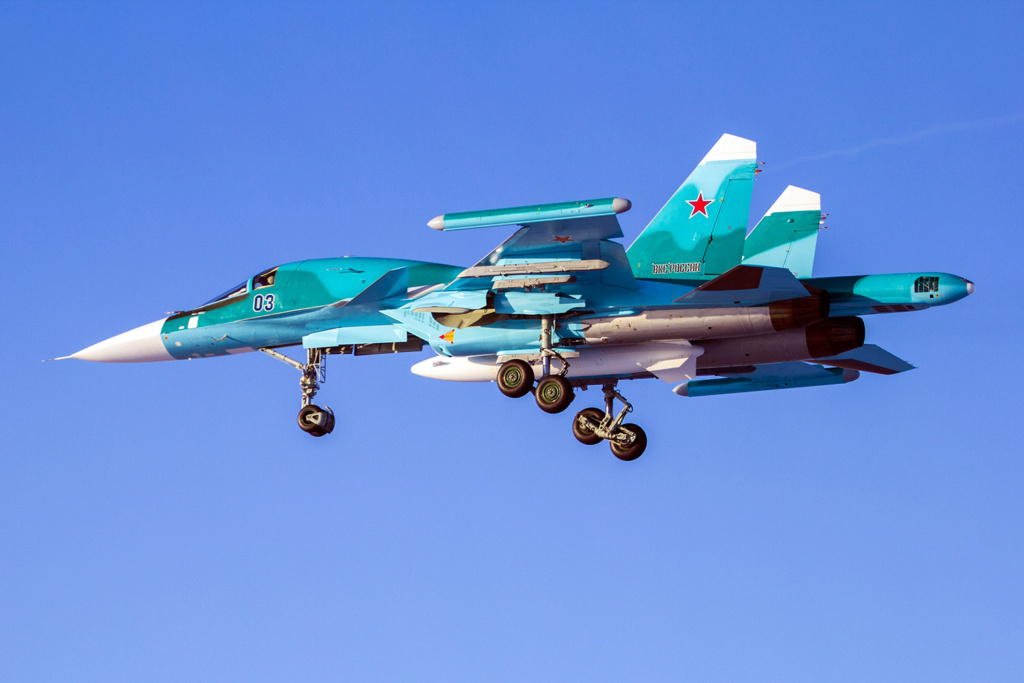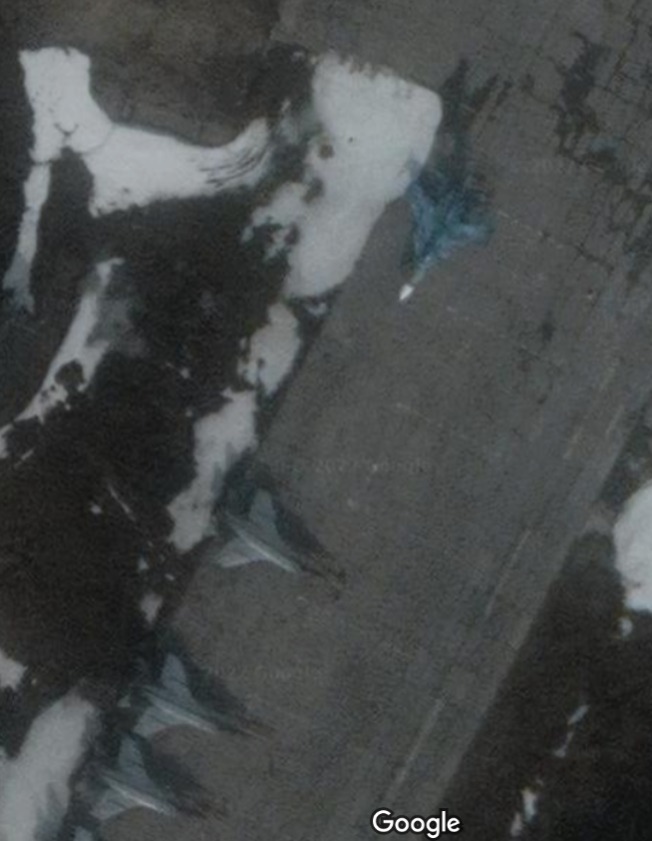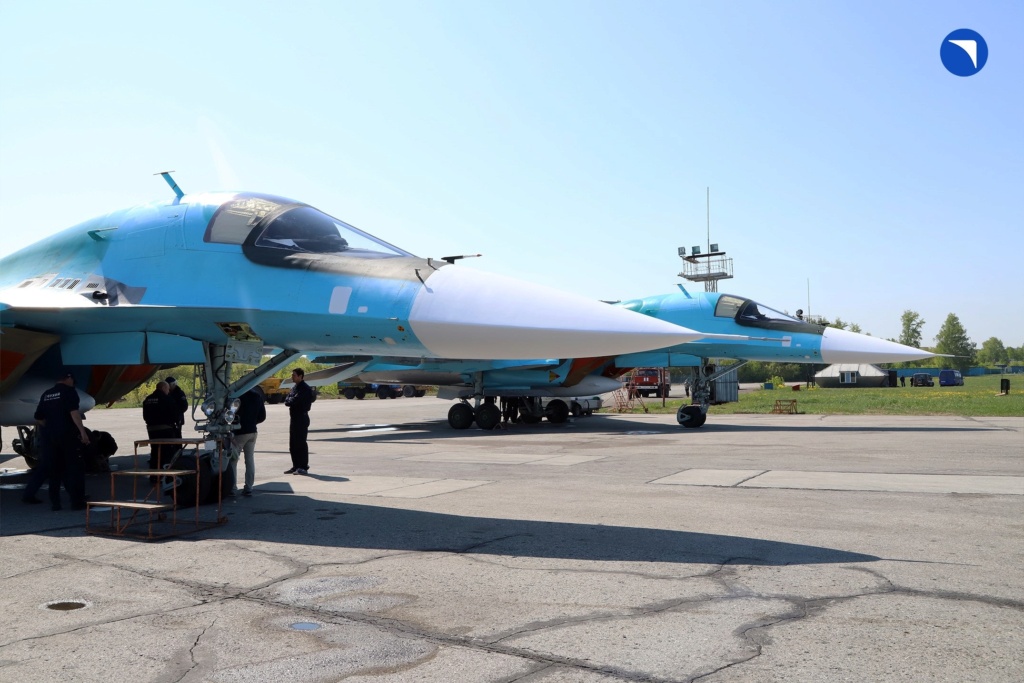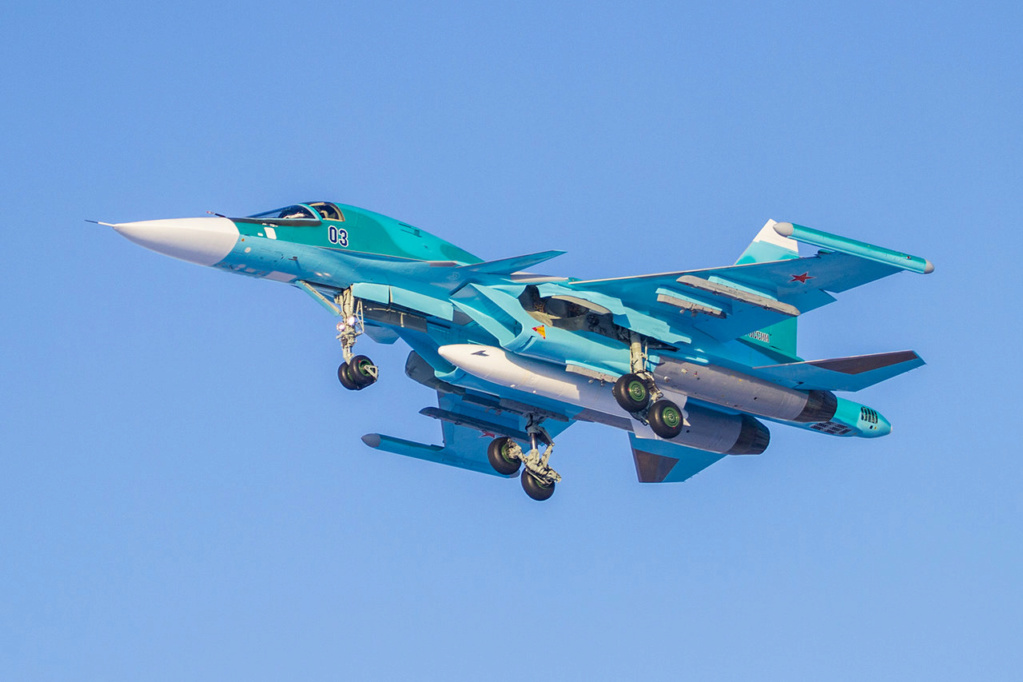Su-34 Tactical Bomber: News #2

TMA1- Posts : 1156
Points : 1154
Join date : 2020-11-30
- Post n°351
 Re: Su-34 Tactical Bomber: News #2
Re: Su-34 Tactical Bomber: News #2
Hole and Belisarius like this post

AMCXXL- Posts : 1006
Points : 1006
Join date : 2017-08-08
- Post n°352
 Re: Su-34 Tactical Bomber: News #2
Re: Su-34 Tactical Bomber: News #2
Arkanghelsk wrote:
Excellent work ,
So it seems the losses were basically recovered and new squadrons are filled out
Fucking great, now to protect these machines and augment the light fighter fleet
***edit, if we take western exaggerated claims of 16 downed
We take 140 operational (not counting 7 prototypes) , minus 16, yields 124 remaining aircraft +- assorted losses, plus 10 aircraft delivered this year, puts the fleet around 134 planes
This is good , if 4 more are delivered at year end, it will be back to 138 , circa 140 aircraft since beginning of SMO
I don't think so, when the previous contract ended there were 10 full squadrons plus two planes in Akhtubisnk, now there are 11 full squadrons, we are talking about 134 planes, from which we must discount the casualties of 2022.
Of the 151 airframes manufactured as a maximum must be discounted 7 prototypes , 1 static airframe and 5 pre-series for tests that have already been withdrawn, that is, 13 fewer: remain 138.
Several (about 4) were lost in the previous decade and about 12-15 this year
TMA1 wrote:I believe the Su-34NVO are capable of using the new jamming and recon pods. Particularly interested in the pod with the powerful side looking radar with long range and meter squared or less SAR mapping capabilities. I wonder if it is good enough to track long range targets for strike.
Yes, Su-34NVO is not a modernized version is a version with more capacities, included recon pods
The modernized version should include better engines and other updates
https://lenta.ru/news/2022/11/18/ntcnn/
In the United States, the production of Su-34 in Russia was estimated
The multifunctional front-line supersonic fighter-bomber Su-34 is a favorite of the Russian Ministry of Defense . An assessment of the pace of production of the Russian aircraft was given by the American magazine Military Watch.
The publication admits that at the beginning of 2022, the Russian Aerospace Forces (VKS) were armed with 125 such interceptor fighters. According to the magazine, the Ministry of Defense received about 14 Su-34s each year.
“This is expected to continue until at least the end of the 2020s. One of the main reasons why these aircraft were purchased in greater numbers than the Su-30SM and Su-35S, which are also high-maintenance heavy fighters, is that the Su-34 was produced exclusively for domestic use, while while a significant part of the production capacity of the other two models worked for export, ”the publication says.
The magazine claims that fighter-interceptors are "prized for their long range, comparable to that of some strategic bombers, and powerful electronic warfare systems, which, combined with a relatively small effective scattering area, make them difficult to intercept."
The publication admits that if the Su-34s receive engines from the Su-57 fighter, then the capabilities of the first will grow revolutionary.
In November , the Russian Ministry of Industry and Trade announced that another batch of Su-34 front-line fighter-bombers had been handed over to the Russian Armed Forces.
GarryB, franco, JPJ, Hole, Broski and Arkanghelsk like this post

Arkanghelsk- Posts : 3837
Points : 3843
Join date : 2021-12-08
- Post n°353
 Re: Su-34 Tactical Bomber: News #2
Re: Su-34 Tactical Bomber: News #2
AMCXXL wrote:
I don't think so, when the previous contract ended there were 10 full squadrons plus two planes in Akhtubisnk, now there are 11 full squadrons, we are talking about 134 planes, from which we must discount the casualties of 2022.
Of the 151 airframes manufactured as a maximum must be discounted 7 prototypes , 1 static airframe and 5 pre-series for tests that have already been withdrawn, that is, 13 fewer: remain 138.
Several (about 4) were lost in the previous decade and about 12-15 this year
Thank you for your clearing it up!

mack8- Posts : 1039
Points : 1093
Join date : 2013-08-02
- Post n°354
 Re: Su-34 Tactical Bomber: News #2
Re: Su-34 Tactical Bomber: News #2
GarryB, franco, JPJ, Big_Gazza, JohninMK, zardof, AMCXXL and like this post

AMCXXL- Posts : 1006
Points : 1006
Join date : 2017-08-08
- Post n°355
 Re: Su-34 Tactical Bomber: News #2
Re: Su-34 Tactical Bomber: News #2
@mack8
Is this a new Su-34? Beautiful image anyway.
Yes , it is new, have a blue tactical number, it is the first known with blue numbers
The question is where is destined, is for a new bomber regiment, no doubt, and is for VKS
In first place i thougt that could be for Monchegorsk, because one Su-34 appeared in google last summer, but Monchegorsk is of North Fleet (for the moment)
One can speculate if it is for a new regiment in the new Leningrad Military District that the MoD has announced a few days ago, the exact location remains to be seen (Siversky ?? in Leningrad oblast, former base of 67º BAP, disbanded in 2009)

GarryB, JPJ, mack8, zardof, LMFS, Hole and jon_deluxe like this post

mack8- Posts : 1039
Points : 1093
Join date : 2013-08-02
- Post n°356
 Re: Su-34 Tactical Bomber: News #2
Re: Su-34 Tactical Bomber: News #2
https://bmpd.livejournal.com/4637843.html
franco and LMFS like this post

George1- Posts : 18400
Points : 18897
Join date : 2011-12-22
Location : Greece
- Post n°357
 Re: Su-34 Tactical Bomber: News #2
Re: Su-34 Tactical Bomber: News #2
- The total number of Su-34Ms built in 2022 are 10 units,
- The total number of aircraft manufactured under the 2020 contract (30 units) are 14 aircrafts.
- In August 2022, according to available information, the Russian Ministry of Defense signed a new contract with UAC for the manufacture of a certain number of Su-34M aircraft (according to unofficial data, about 15 units).
franco, zepia, LMFS, jon_deluxe and Belisarius like this post

AMCXXL- Posts : 1006
Points : 1006
Join date : 2017-08-08
- Post n°358
 Re: Su-34 Tactical Bomber: News #2
Re: Su-34 Tactical Bomber: News #2
George1 wrote:
Some key points from bmpd article:
- The total number of Su-34Ms built in 2022 are 10 units,
- The total number of aircraft manufactured under the 2020 contract (30 units) are 14 aircrafts.
- In August 2022, according to available information, the Russian Ministry of Defense signed a new contract with UAC for the manufacture of a certain number of Su-34M aircraft (according to unofficial data, about 15 units).
Of course not
In first time, current contract is for 24, not 30
Second is not clear how many heve been manofactured in 2022, and not clear the destiny of airplanes
Thitd, last year were transferred two batchs instead one
bmpd himself said 6 was transferred in 2021 If you review his previous articles of the "Su-34" tag
However, this is not correct, the known planes from last year had No. 50, 52, 53, 55 and 16, which I guess was at least 50 to 55 or 56 in addition to No. 16, that is 7 or 8 planes in 2021
I am inclined to think that in 2021 8 were received, while this year there could be 10 but also 12, nothing is known about how many the last two batches have been received, there is no evidence that there are 3, and the fact that the Nº03 blue has been seen, it does not mean that this plane is the third, in fact it may be the first and there may be a Nº04 blue, Nº05, etc...
Most likely, the lots are 4 each and are distributed according to the needs
The fact is that a new contract has been signed because there are not enough remaining for next year (The complete cycle of the plane lasts about a year)
18 at least have been manofactured from the current contract of 24. Next year will be fullfilled and probably the other for "arround 15" also will be, given that the production will grow to the maximun under war production conditions
In 2023 also is necesary sign the contract for 76 machines announced previously
JPJ, mack8, zepia, LMFS, Hole, jon_deluxe and Belisarius like this post

mack8- Posts : 1039
Points : 1093
Join date : 2013-08-02
- Post n°359
 Re: Su-34 Tactical Bomber: News #2
Re: Su-34 Tactical Bomber: News #2
Su-34 video from Syria dated January 1st (occasioned by ground and air crews receiving new year gifts etc.)
https://tvzvezda.ru/news/2023111459-CvhFE.html

Krepost- Posts : 741
Points : 743
Join date : 2021-12-08
- Post n°360
 Re: Su-34 Tactical Bomber: News #2
Re: Su-34 Tactical Bomber: News #2
Is this new delivery really consisting of Su-34M or is it Su-34 ???

AMCXXL- Posts : 1006
Points : 1006
Join date : 2017-08-08
- Post n°361
 Re: Su-34 Tactical Bomber: News #2
Re: Su-34 Tactical Bomber: News #2
Krepost wrote:I know the bmpd site says Su-34M.
Is this new delivery really consisting of Su-34M or is it Su-34 ???
bmpd say a lot of things, but the airplane is oficially Su-34NVO
about the deliveries, in google there is one Su-34 in Monchegorsk since (at least) october or the end of september
probably here is the destiny of Su-34´s with blue numbers
During 2023, a regiment of Su-34 should be completed in this area for the new Leningrad Military District.
From the Monchegorsk units you can take out a regiment of MiG-31 fighters and a regiment of Su-34 bombers

Last edited by AMCXXL on Wed Jan 04, 2023 6:08 am; edited 3 times in total
franco likes this post

caveat emptor- Posts : 1870
Points : 1870
Join date : 2022-02-02
Location : Murrica
- Post n°362
 Re: Su-34 Tactical Bomber: News #2
Re: Su-34 Tactical Bomber: News #2
franco, JPJ, jon_deluxe and Arkanghelsk like this post

Hole- Posts : 10982
Points : 10962
Join date : 2018-03-24
Age : 48
Location : Scholzistan
- Post n°363
 Re: Su-34 Tactical Bomber: News #2
Re: Su-34 Tactical Bomber: News #2
GarryB, George1, zardof, jon_deluxe, Arkanghelsk, Belisarius and Podlodka77 like this post

Hole- Posts : 10982
Points : 10962
Join date : 2018-03-24
Age : 48
Location : Scholzistan
- Post n°364
 Re: Su-34 Tactical Bomber: News #2
Re: Su-34 Tactical Bomber: News #2
The crews of Su-34 front-line bombers have received (https://tass.ru/armiya-i-opk/17663845) the ability to use FAB-250 high-explosive air bombs without entering the enemy's air defence zone.
The module consists of a winged platform and a navigation system, which allows it to deliver accurate strikes at predetermined coordinates.
At a speed of 800-900 km/h, the bomb module can be launched at distances of up to 80 km.
Twitter source
GarryB, psg, JPJ, flamming_python, xeno, zardof, LMFS and like this post

Podlodka77- Posts : 2589
Points : 2591
Join date : 2022-01-06
Location : Z
- Post n°365
 Re: Su-34 Tactical Bomber: News #2
Re: Su-34 Tactical Bomber: News #2
updated June 1, 11:12
UAC handed over another batch of Su-34 front-line bombers to the Russian Aerospace Forces
The aircraft passed a complex of ground and flight tests, the company said.
MOSCOW, June 1. /TASS/. The United Aircraft Corporation (UAC, part of the state corporation Rostec) handed over another batch of Su-34 front-line bombers to the Russian Aerospace Forces. This was announced by the company.
"The UAC handed over to the Russian Aerospace Forces another batch of Su-34 front-line bombers. These beauties were manufactured at the Novosibirsk Aviation Plant named after V.P. Chkalov. The aircraft passed a set of ground and flight tests and were handed over to the Russian Ministry of Defense. Su-34 front-line bombers form an important part of the strike the power of Russian front-line aviation," the statement said.
https://tass.ru/armiya-i-opk/17900337
GarryB, franco and LMFS like this post

Podlodka77- Posts : 2589
Points : 2591
Join date : 2022-01-06
Location : Z
- Post n°366
 Re: Su-34 Tactical Bomber: News #2
Re: Su-34 Tactical Bomber: News #2
bmpd
June 1st, 7:08 pm
PJSC United Aircraft Corporation (UAC, part of the Rostec State Corporation) announced on June 1, 2023 that the next batch of new Su-34 front-line bombers was manufactured at the Novosibirsk Aviation Plant named after V.P. Chkalov UAC. The aircraft passed a complex of ground and flight tests and were handed over to the Ministry of Defense of the Russian Federation.

Two front-line bombers Su-34M (Su-34NVO) of the new construction of the Novosibirsk Aviation Plant named after V.P. Chkalov PJSC United Aircraft Corporation. The side numbers in the photo are retouched. Novosibirsk, 06/01/2023 (c) United Aircraft Corporation PJSC
“UAC delivers aircraft under the current year program. On the eve of the VTA, another Il-76MD-90A was handed over. The batch of Su-34s is the first delivery of tactical aircraft this year. UAC as part of Rostec faces the most important task - providing the Russian Ministry of Defense with new highly efficient aviation systems, - said Yury Slyusar, General Director of the United Aircraft Corporation. “We are fulfilling our obligations under the state defense order in a timely manner, and together with the military, we are carrying out the necessary work to maintain the fleet of aircraft in operation.”
On the part of bmpd, we point out that only two new Su-34M aircraft are shown on the official photos from the broadcast distributed by the UAC. Their tail and registration numbers, as well as the numbers of aircraft supplied to the Russian Aerospace Forces in 2022, have been retouched. The aircraft delivered on June 1 became the first batch of Su-34M aircraft built by the Novosibirsk Aviation Plant named after V.P. Chkalov (NAZ) in 2023, and the next batch under the three-year contract concluded in June 2020 by the Ministry of Defense of the Russian Federation with the UAC for the construction of 24 modernized Su-34M (Su-34NVO) bombers.
The first six Su-34M aircraft under this contract were manufactured by NAZ in 2021; -th mixed aviation division of the 11th Red Banner Army of the Air Force and Air Defense of the Eastern Military District (since November 2022, this regiment, which is actively participating in the special military operation in Ukraine, has the rank of Guards), and the other two in December - to the 4th Order of Lenin of the Red Banner Center for military testing and training of personnel of the VKS named after V.P. Chkalov Ministry of Defense of the Russian Federation to the Lipetsk airfield .. Then in 2022, three more batches of bombers were transferred to the Aerospace Forces - a total of 10 aircraft. Of these, at least four aircraft were also delivered to the 277th Bomber Aviation Regiment in June 2022, and the appointment of the remaining six (parties in December and November) was not reported.
If two more bombers have now been delivered, then the total number of Su-34s built has reached 157 units, including seven experimental and pre-production aircraft.
In August 2022, according to available information, the Russian Ministry of Defense signed a new contract with the UAC for the manufacture of a certain number of Su-34M aircraft.

https://bmpd.livejournal.com/4707333.html
GarryB, franco, zardof, Hole, Broski and jon_deluxe like this post

George1- Posts : 18400
Points : 18897
Join date : 2011-12-22
Location : Greece
- Post n°367
 Re: Su-34 Tactical Bomber: News #2
Re: Su-34 Tactical Bomber: News #2

AMCXXL- Posts : 1006
Points : 1006
Join date : 2017-08-08
- Post n°368
 Re: Su-34 Tactical Bomber: News #2
Re: Su-34 Tactical Bomber: News #2
George1 wrote:so we have 20 aircrafts delivered in total out of 24 (of the 2020 contract)
There is no confirmation of how many aircraft have been delivered in the last two years, also since December it is forbidden to publish images of any aircraft other than those delivered by the MoD
In the period 2010-2020, 126 serial aircraft were delivered (32+92+2 options)
In 2021 it has confirmed the delivery of 7 for the images, probably 8 in total
In 2022 there are 3 confirmed batches, the amount could be from 10 to 12, there is nothing certain, no official confirmation of the amount or any image apart from a plane with the blue number 03 that confirms the creation of a new regiment with Su-34, probably in the new Leningrad Military District or maybe directly to Monchegorsk
On the other hand, this first batch of 2023 there is only an image of 2 aircraft in the factory, that does not mean that they cannot be more
In the current war conditions, it cannot be ruled out that the factories are producing the maximum number of aircraft that they are capable of, regardless of what is officially announced.and regardless of previously announced peacetime contracts. The production plans were changed last year and we don't know how much weapons Russia is really manufacturing, and they won't tell us.
Let's remember that NAPO can produce perhaps 20 Su-34 planes a year at the most and it managed to manufacture 18 planes some years, IRKUT for its part can manufacture up to 36 Su-30SM a year and in the past it has already manufactured 31 Su-30SM in a single year
sepheronx, GarryB, franco, JPJ, zardof, Hole, owais.usmani and lancelot like this post

Isos- Posts : 11379
Points : 11347
Join date : 2015-11-06
- Post n°369
 Re: Su-34 Tactical Bomber: News #2
Re: Su-34 Tactical Bomber: News #2
GarryB, franco, George1, dino00, Hole, Kiko and Broski like this post

Kiko- Posts : 3203
Points : 3261
Join date : 2020-11-11
Age : 75
Location : Brasilia
- Post n°370
 Re: Su-34 Tactical Bomber: News #2
Re: Su-34 Tactical Bomber: News #2
Real breakthrough here is the significant reduction in Kinzhal's weight keeping its punch!Isos wrote:
GarryB, owais.usmani and Broski like this post

Tsavo Lion- Posts : 5953
Points : 5907
Join date : 2016-08-15
Location : AZ, USA
- Post n°371
 Re: Su-34 Tactical Bomber: News #2
Re: Su-34 Tactical Bomber: News #2
https://vz.ru/society/2023/9/4/1228830.html
https://lenta.ru/news/2023/09/04/su34mig31/
https://nsn.fm/in-the-world/infobrics-vooruzhennyi-kinzhalami-su-34-stal-ugrozoi-dlya-kieva-i-nato
https://riamo.ru/article/668604/mwm-kinzhaly-na-su-34-rasshiryat-vozmozhnosti-rossii-na-svo

GarryB- Posts : 39671
Points : 40167
Join date : 2010-03-30
Location : New Zealand
- Post n°372
 Re: Su-34 Tactical Bomber: News #2
Re: Su-34 Tactical Bomber: News #2
Big_Gazza likes this post

mnztr- Posts : 2845
Points : 2883
Join date : 2018-01-21
- Post n°373
 Re: Su-34 Tactical Bomber: News #2
Re: Su-34 Tactical Bomber: News #2
Tsavo Lion wrote:I expected that development! More info.:
https://vz.ru/society/2023/9/4/1228830.html
https://lenta.ru/news/2023/09/04/su34mig31/
https://nsn.fm/in-the-world/infobrics-vooruzhennyi-kinzhalami-su-34-stal-ugrozoi-dlya-kieva-i-nato
https://riamo.ru/article/668604/mwm-kinzhaly-na-su-34-rasshiryat-vozmozhnosti-rossii-na-svo
I wonder how much range is lost launching from the SU-34 after all the MIG 31 can fly over 20K feet higher and 1100 KPH faster. I am not sure of the release envelope of the Kinzhal so it may be a lot or nothing, but I think the choice of the MIG-31 was not an accident as it can haul it right to its cruising altitude and going from 1900 kph to 3000 KPH, I would imagine would require a LOT of fuel

Tsavo Lion- Posts : 5953
Points : 5907
Join date : 2016-08-15
Location : AZ, USA
- Post n°374
 Re: Su-34 Tactical Bomber: News #2
Re: Su-34 Tactical Bomber: News #2

mnztr- Posts : 2845
Points : 2883
Join date : 2018-01-21
- Post n°375
 Re: Su-34 Tactical Bomber: News #2
Re: Su-34 Tactical Bomber: News #2
Tsavo Lion wrote:with more planes to carry them, more strikes can be done, so even if they r slower & easier to intercept, many will still hit their targets; also the enemy will expend more SAMs & expose their positions for strikes on them.
That makes sense i suppose but even with 10 Mig-31s modded to launch these they can easily do 3 sorties/day, launching 30 missiles. I don't think they have ever used more then 10 in one day.
|
|
|


 AMCXXL
AMCXXL

